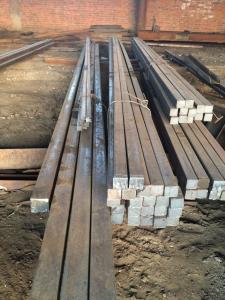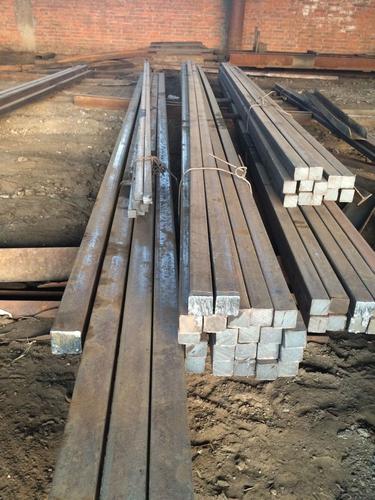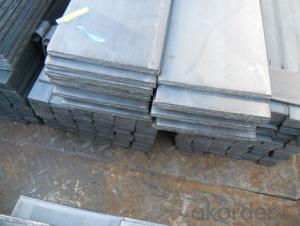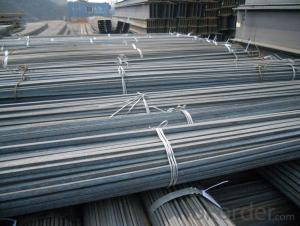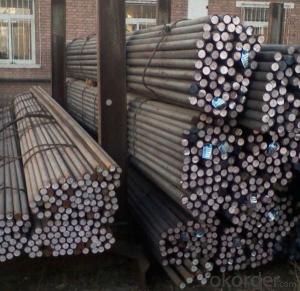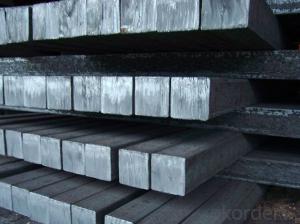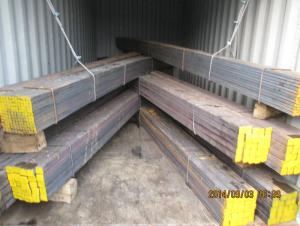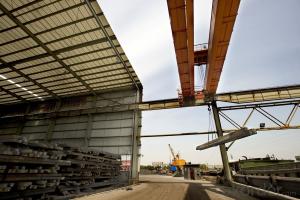Hot Rolled Square Steel Bars Q235
- Loading Port:
- Tianjin
- Payment Terms:
- TT OR LC
- Min Order Qty:
- -
- Supply Capability:
- 200000 m.t./month
OKorder Service Pledge
OKorder Financial Service
You Might Also Like
Hot Rolled Square Bar Details:
| Minimum Order Quantity: | 50Tons | Unit: | m.t. | Loading Port: | Tianjin Port |
| Supply Ability: | 500 tons per month | Payment Terms: | TT or LC |
Product Description:
Specifications of Hot Rolled Square Bar Q235:
-Standard: GB,
-Grade: Q235 or equivalent.
Chemical Composition:
Standard | Grade | Element (%) | ||||
GB | Q235B | C | Mn | S | P | Si |
0.12~0.20 | 0.30~0.70 | ≤0.045 | ≤0.045 | ≤0.30 | ||
Measures of Hot Rolled Square Bar:
(Section of HR Square Bar)
-Length of a side and Theoretical weight of Square Bar.
Length of a side(mm) | Theoretical weight(kg/m) | Length of a side(mm) | Theoretical weight(kg/m) |
6 | 0.283 | 32 | 8.04 |
7 | 0.385 | *33 | 8.55 |
8 | 0.502 | 34 | 9.07 |
9 | 0.636 | *35 | 9.62 |
10 | 0.785 | 36 | 10.17 |
11 | 0.950 | 38 | 11.24 |
12 | 1.13 | 40 | 12.56 |
13 | 1.33 | 42 | 13.85 |
14 | 1.54 | 45 | 15.90 |
15 | 1.77 | 48 | 18.09 |
16 | 2.01 | 50 | 19.63 |
17 | 2.27 | 53 | 22.05 |
18 | 2.54 | *55 | 23.6 |
19 | 2.82 | 56 | 24.61 |
20 | 3.14 | *58 | 26.4 |
21 | 3.46 | 60 | 28.26 |
22 | 3.80 | 63 | 31.16 |
*23 | 4.15 | *65 | 33.17 |
24 | 4.52 | *68 | 36.3 |
25 | 4.91 | 79 | 38.49 |
26 | 5.30 | 75 | 44.16 |
*27 | 5.72 | 80 | 50.24 |
28 | 6.15 | 85 | 56.72 |
*29 | 6.60 | 90 | 63.59 |
30 | 7.06 | 95 | 70.85 |
*31 | 7.54 | 100 | 78.50 |
Notes:
1, The theoretical weights in the list, base on the density of 7.85 g/cm3.
2, Formula for theoretical weight of Square bar: a(length of a side) * a * 0.00785
3, The numbers with *mean that they are not regular or we don’t offer them.
-Regular length of Square Bar:
Steel | Length of a side (mm) | Length of steel (m) |
Normal steel | < 25 | 4~10 |
> 25 | 3~9 | |
Steel of high quality | All measure | 2~6 |
Tool steel >75 | 1~6 |
Usage/Applications of Hot Rolled Square Bar:
-The Square Steel is normally used as structure steel.
-Row material for other structure steel like steel angles, channels, I-beams, H-beams, etc…
-Row material for steel pipes.
Packaging & Delivery of Hot Rolled Square Bar:
-Packing Detail: The products can be packed in bundles by steel wires.
-Marks:
1, Tag marks: the tag marks will be tied up to each bundle of the products. The information is usually including supplier’s logo and name, product name, made in China, products’ specifications, the painted color and other information requested by customers.
2, Color marks: we will paint both ends of the bundles of these products to make sure that they are more evident. It’s will be more convenient for the customers to distinguish them at the destination port.
-Delivery Detail: 30~45 working days after receive buyer’s T.T. or L/C.
Transportation:
-The products can be delivered by bulk vessel or by container. As for container, products with the length of 6m will be loaded in 20’ container, with 9m or 12m, in 40’ container.
-The maximum quantity of loading of container is 25 tons.
-The products are usually transported to the nearest port from the production place.
Payment:
-Invoicing on theoretical weight or actual weight as customer’s request.
-FOB, CFR or CIF.
-Regular terms of payment:
1, 30% payment in advance, the remaining balance (70% payment) against the copy of B/L.
2, 30% payment in advance, the remaining balance (70% L/C) against the copy of B/L.
3, Negotiable.
Photos of Hot Rolled Square Bar:
-Products in the factory:

-Products during transportation:
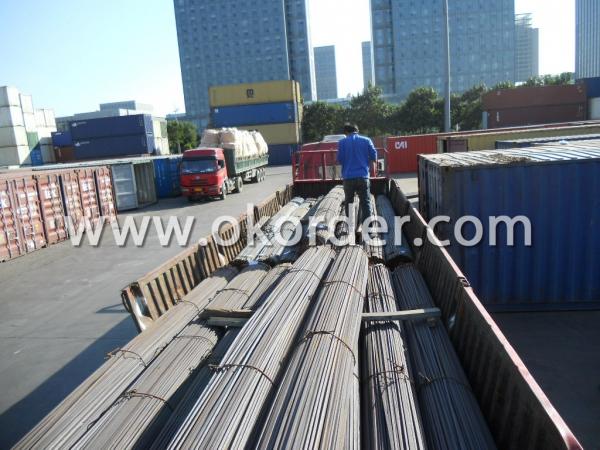
We sincerely welcome partners around the world to establish business cooperation with us on the basis of mutual trust, benefit and development.
- Q: How do you use a steel square to determine the slope of a deck?
- To find the slope of a deck using a steel square, you can proceed as follows: 1. Locate a flat and level surface near the deck, such as the ground or a nearby table. 2. Place the steel square on the flat surface, ensuring it is completely level. You can verify this using a bubble level. 3. Position the steel square against a vertical post or wall of the deck. Align one side of the square with the post while extending the other side towards the deck's edge. 4. Once the steel square is in the correct position, use a carpenter's level or a plumb bob to establish a vertical line. This will serve as a reference point for measuring the slope. 5. Measure the distance between the horizontal edge of the steel square and the deck's surface, starting from the vertical line. You can utilize a tape measure or ruler for this step. 6. Take note of this measurement, as it represents the rise or drop in height over a specific distance. 7. To determine the slope, divide the rise or drop in height by the distance measured in the previous step. This calculation will yield the slope ratio or gradient of the deck. For instance, if you measured a 1-inch rise over a 12-inch distance, the slope would be expressed as 1:12 or 1/12. By following these steps and employing a steel square in conjunction with a level, you can accurately ascertain the slope of a deck. This information is crucial for ensuring proper drainage, preventing water accumulation, and maintaining the deck's structural integrity.
- Q: Can a steel square be used for measuring diagonals?
- Yes, a steel square can be used for measuring diagonals. A steel square, also known as a framing square or carpenter's square, is a versatile tool commonly used in woodworking and construction. It has a 90-degree angle and a long blade with measurements marked along its edges. To measure diagonals, you can simply align the square's blade along one side of the object or surface, and then extend the square's other edge diagonally to the opposite corner. The length of the diagonal can then be measured using the markings on the square, providing an accurate measurement.
- Q: Can a steel square be used for checking the alignment of ceiling tiles?
- Checking the alignment of ceiling tiles can indeed be done using a steel square. This versatile tool, commonly found in carpentry and woodworking, is perfect for measuring and marking right angles. Its straight edges and 90-degree angle are ideal for ensuring the alignment and squareness of various objects, including ceiling tiles. By simply placing the steel square against the tile edges, you can easily determine if they are properly aligned or if any adjustments are necessary. However, it's worth noting that a steel square may not be the most practical option for larger areas or ceilings with intricate layouts. Since it is a handheld tool that requires multiple measurements, a laser level or specialized tile alignment tools may prove more efficient in such cases.
- Q: Can a steel square be used for cabinet hardware installation?
- No, a steel square is not typically used for cabinet hardware installation. Cabinet hardware installation usually requires specific tools such as drills, screwdrivers, and measuring tapes.
- Q: How do you use a steel square for creating parallel lines?
- To create parallel lines using a steel square, follow these steps: 1. Place the steel square onto the surface or material where the parallel lines are desired. 2. Align one edge of the steel square with the reference point or starting edge for the parallel lines. 3. Securely hold the steel square in place to prevent any movement. 4. Use a pencil or marking tool to make a mark or draw a line along the edge of the steel square. 5. Without shifting the steel square, glide it along the surface or material while maintaining alignment with the reference point. 6. Make another mark or draw another line along the edge of the steel square at the desired distance from the previous line. 7. Repeat this process for the desired number of parallel lines, consistently aligning the same edge of the steel square with the reference point and marking along the opposite edge. By consistently aligning the steel square with the reference point and marking along its edges, one can create multiple parallel lines with precision and accuracy.
- Q: Can a steel square be used for wainscoting installation?
- Wainscoting installation can indeed utilize a steel square. A steel square is a tool that is both versatile and durable, frequently employed in carpentry and woodworking projects. Its primary function is aiding in the measurement and marking of right angles, as well as guaranteeing accurate cuts and joinery. During wainscoting installation, a steel square proves useful for marking and measuring the height and width of the panels, ensuring proper alignment and levelness. Additionally, it can assist in verifying squareness and making precise cuts when trimming panels to accommodate corners or obstacles. In summary, a steel square serves as a valuable asset for achieving meticulous and professional wainscoting installation.
- Q: How do you use a steel square to mark out parallel lines on irregular surfaces?
- To use a steel square to mark out parallel lines on irregular surfaces, follow these steps: 1. Ensure that the steel square is clean and free from any dirt or debris. This will help maintain accurate measurements. 2. Identify the two points on the irregular surface where you want to mark the parallel lines. It could be the edges of a board or any other reference points you choose. 3. Place the steel square on the surface, aligning one side of the square with one of the reference points. Hold the square firmly in place. 4. Using a pencil or a scribe, slide it along the edge of the square, marking a line on the surface. 5. Now, align the same side of the square with the other reference point and repeat the process of marking a line. 6. You will now have two parallel lines marked on the irregular surface, equidistant from the reference points. 7. If you need to mark more parallel lines, simply repeat steps 3 to 6, aligning the square with the previously marked lines. It's important to note that the accuracy of the parallel lines will depend on the precision of your measurements and the stability of the steel square during the marking process. Also, be cautious of any irregularities or bumps on the surface that may affect the accuracy of the lines.
- Q: Can a steel square be used for barn construction?
- Yes, a steel square can be used for barn construction. A steel square is a versatile and durable tool that can be used for various tasks in construction, including layout, marking, and checking right angles. It can be used to ensure precise measurements and angles when framing walls, installing rafters, or creating trusses in a barn. Additionally, steel squares are resistant to warping and corrosion, making them a reliable choice for long-term use in barn construction. However, it is important to note that the specific requirements and regulations for barn construction may vary depending on the location and building codes, so it is advisable to consult with a professional or local authorities to ensure compliance with the necessary standards.
- Q: How do you use a steel square to determine angles for wainscoting?
- To determine angles for wainscoting, one can follow a few steps: 1. Take measurements of the height and width of the installation area to determine the size and dimensions of the wainscoting panels. 2. Position the steel square against the wall, ensuring it is flush and level. Place the long edge of the square against the wall and the shorter edge facing outward. 3. Align one leg of the square with the bottom edge of the wall or baseboard, while keeping the other leg perpendicular to the wall. 4. Use a pencil or marker to trace a line along the longer edge of the square. This line will serve as a reference for cutting or installing the wainscoting panels. 5. Then, use a tape measure to mark the height of the wainscoting panels on the wall. This will help determine the placement of the top edge of the wainscoting. 6. Align the square with the mark indicating the top edge of the wainscoting and trace another line along the longer edge of the square. 7. By connecting the two traced lines, a reference angle for the wainscoting will be established. This angle will guide the cutting and fitting of the top and bottom edges of the wainscoting panels to ensure a proper fit on the wall. 8. Repeat this process for each wall section where wainscoting will be installed, ensuring that the square is aligned and level each time. By utilizing a steel square in this manner, precise and accurate angles can be achieved for wainscoting installation, resulting in a professional and visually appealing outcome.
- Q: How is a steel square used in woodworking?
- The steel square, a versatile tool in woodworking, serves various purposes. Its primary function lies in accurately measuring and marking right angles. To assess the squareness of a project or workpiece, one commonly employs a steel square. Woodworkers rely on it to verify the perfect 90-degree corners of furniture, such as tables or cabinets. This step is vital for securing stability and guaranteeing the overall quality of the final product. Furthermore, a steel square facilitates the process of laying out and marking angles. By positioning the square against the wood's edge, woodworkers can effortlessly denote precise angles, be it 45 degrees, 30 degrees, or any other desired measurement. This proves particularly advantageous when cutting or joining wood pieces at specific angles, as in the construction of frames or joints. Moreover, a steel square functions as a guide for executing straight and accurate cuts. Aligning the square along the wood's edge and utilizing a saw or another cutting tool along it ensures that the cuts remain perfectly perpendicular to the surface. This becomes especially crucial when striving for clean and precise cuts, whether for creating joints or sizing lumber. Overall, the steel square stands as an irreplaceable tool within woodworking. It plays a crucial role in achieving precision and accuracy in measuring, marking, and cutting wood, thereby guaranteeing the final project's superior quality and adherence to required specifications.
Send your message to us
Hot Rolled Square Steel Bars Q235
- Loading Port:
- Tianjin
- Payment Terms:
- TT OR LC
- Min Order Qty:
- -
- Supply Capability:
- 200000 m.t./month
OKorder Service Pledge
OKorder Financial Service
Similar products
Hot products
Hot Searches
Related keywords
